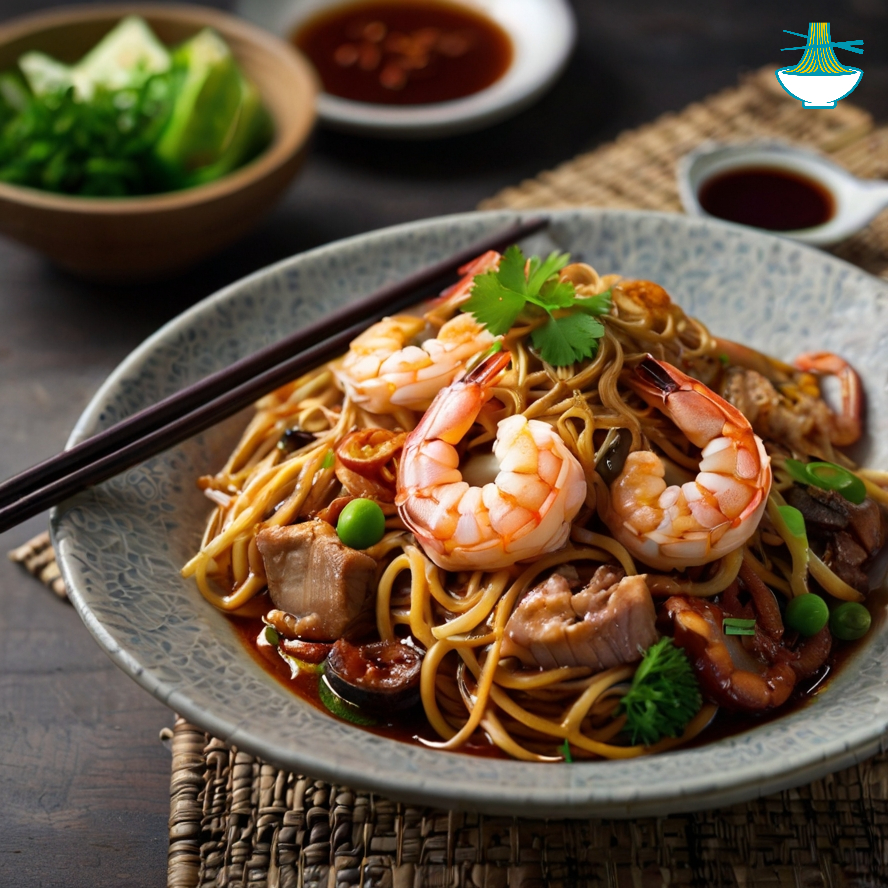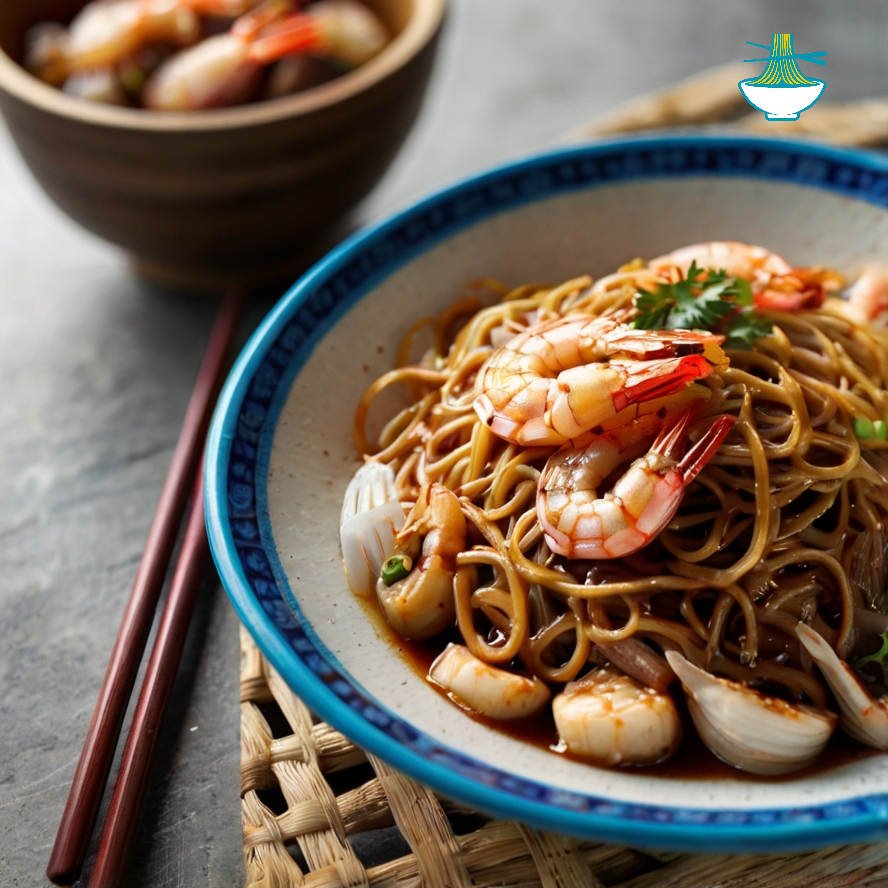Hokkien Mee, a popular Penang specialty, is a flavorful combination of proteins, carbohydrates, and nutrients. Hokkien Mee is a beloved dish in Malaysian cuisine and often featured in Singaporean food menus. Prawns are an excellent source of lean protein, selenium, and omega-3 fatty acids, supporting heart health and immunity. The dish is a great option for prawn recipes, offering a rich taste. Pork belly recipes also shine in this dish, as the pork adds additional protein and essential minerals like zinc and iron, which are vital for immune and blood health. The Hokkien noodles and rice vermicelli provide carbohydrates for energy, while dark soy sauce enhances the dish with its deep umami flavor. Though indulgent, mindful portion sizes make this a well-rounded and satisfying meal, perfect for anyone seeking delicious stir-fry recipes. The noodles, a staple in Asian noodles cuisine, provide a perfect base for this hearty meal.
Ingredients:
- 200g yellow noodles
- 100g rice vermicelli
- 200g prawns, peeled and deveined
- 150g pork belly, thinly sliced
- 2 tbsp dark soy sauce
- 1 tbsp light soy sauce
- 2 cloves garlic, minced
- 2 tbsp vegetable oil
- 1 cup chicken stock
- 1/2 cup bean sprouts
- 1 tsp white pepper
- Lime wedges (for garnish)
Preparation Method
- Heat the Oil: Begin by heating 2 tablespoons of vegetable oil in a large wok over medium-high heat. Allow the oil to get hot but not smoking, as this will help achieve a crispy texture on the ingredients as you cook.
- Cook the Garlic: Once the oil is hot, add 2 minced cloves of garlic to the wok. Stir-fry the garlic for about 30 seconds, or until it becomes fragrant and golden brown. Be cautious not to burn it.
- Add Pork Belly: Next, add 150 grams of thinly sliced pork belly to the wok. Stir occasionally to cook the pork belly evenly, allowing it to brown lightly and release its fat. This should take about 4-5 minutes, depending on the heat level.
- Cook the Prawns: Once the pork is lightly browned, toss in 200 grams of peeled and deveined prawns. Stir-fry the prawns for about 2-3 minutes or until they turn a bright pink color and are cooked through. The prawns should be firm and opaque in appearance.
- Add Noodles and Vermicelli: Add the 200 grams of yellow noodles and 100 grams of rice vermicelli to the wok. Use a pair of tongs or chopsticks to gently toss the noodles and vermicelli with the pork and prawns. Ensure they are well combined, as this will allow the flavors to mix throughout the dish.
- Incorporate the Sauces: Stir in 2 tablespoons of dark soy sauce, 1 tablespoon of light soy sauce, and 1 cup of chicken stock. Use a spatula to mix thoroughly, ensuring that the noodles and ingredients are well coated with the sauces. This step adds a rich, savory umami flavor to the dish.
- Add Bean Sprouts and Pepper: After the noodles are well mixed with the sauces, add ½ cup of bean sprouts and 1 teaspoon of white pepper. Toss everything together to combine the ingredients. Cook for another 2 minutes, allowing the bean sprouts to soften slightly and the flavors to meld.
- Final Touch: Once the dish is ready, transfer it to serving plates. Garnish with lime wedges on the side, which will provide a fresh citrusy touch when squeezed over the noodles before eating.
- Serve and Enjoy: Serve the Hokkien Mee hot and enjoy your flavorful, satisfying meal!
This step-by-step method ensures each ingredient is cooked to perfection, providing a delicious balance of flavors and textures in every bite.
Tips for Modifying the Recipe for Different Diets
- Vegetarian Substitution: If you prefer a vegetarian version of this dish, you can easily replace the pork belly with tofu or tempeh. For the prawns, you can use mushrooms (such as shiitake or oyster mushrooms) to mimic the texture and umami flavor. Tofu also offers a good source of plant-based protein.
- Low-Sodium Alternative: To reduce sodium intake, you can replace the dark soy sauce and light soy sauce with low-sodium soy sauce. Additionally, make sure to use unsalted chicken stock or vegetable broth.
- Lower Fat Option: If you're aiming to reduce the fat content, consider using lean chicken breast instead of pork belly, and use a minimal amount of vegetable oil for stir-frying. Alternatively, using olive oil or avocado oil may offer healthier fat options.
Variations in Cooking Methods
- Stir-fry Variation: While this recipe calls for stir-frying, you can also steam the noodles separately and then toss them in the wok with the rest of the ingredients to avoid additional oil. This method helps reduce the overall fat content and still provides a satisfying texture.
- Adding New Ingredients: You can experiment with adding vegetables like carrots, bell peppers, or snow peas for added crunch and nutrition. Additionally, try adding a bit of ginger along with the garlic for a fresh, zesty flavor.
Serving Suggestions
To create a well-rounded meal, you can serve Hokkien Mee alongside:
- Light soups: A simple miso soup or a vegetable broth would complement the dish well.
- Fresh salads: A side salad with a tangy citrus vinaigrette (such as cabbage salad or seaweed salad) can add a refreshing contrast to the rich flavors of the noodles.
- Pickled vegetables: Lightly pickled cucumber or daikon radish adds an extra touch of flavor and helps balance out the richness of the dish.
Frequently Asked Questions (FAQs)
Can this dish be stored for later use?
- Yes, Hokkien Mee can be stored for up to 2-3 days in the refrigerator. To store, place the dish in an airtight container once it has cooled completely. When reheating, you can do so in the microwave or on the stovetop. If reheating on the stovetop, add a splash of water or chicken stock to restore moisture and prevent the noodles from drying out.
For longer storage, you can freeze the dish for up to 1 month. However, keep in mind that the texture of the noodles and the prawns may change slightly after freezing and reheating.
Can this dish be prepared in advance?
Yes, parts of the dish can be prepared ahead of time to save time on the day of cooking:
- Noodles: Cook the noodles and rice vermicelli separately, then store them in an airtight container in the fridge. Reheat them just before combining them with the other ingredients.
- Pork and Prawns: You can pre-cook the pork belly and prawns the night before and store them separately in the fridge. Just stir-fry them briefly with the other ingredients when you're ready to serve.
- Sauce: Prepare the soy sauce mix, chicken stock, and other seasonings ahead of time, so they’re ready to pour into the wok when cooking.
By preparing the individual components in advance, the actual stir-fry process can be completed in just 10-15 minutes.

Nutritional Values and Benefits :
200g Yellow Noodles
- Calories: 400
- Carbohydrates: 80g
- Protein: 12g
Nutritional Benefit: Provides a high-energy base for the dish, essential for fueling the body.
100g Rice Vermicelli
- Calories: 150
- Carbohydrates: 35g
Nutritional Benefit: Adds a light texture and additional carbs for sustained energy.
200g Prawns
- Calories: 200
- Protein: 46g
- Selenium: 40 mcg (73% DV)
Nutritional Benefit: Rich in lean protein and omega-3 fatty acids, supporting heart and brain health.
- 150g Pork Belly
- Calories: 500
- Fat: 45g
- Protein: 12g
Nutritional Benefit: Adds richness and essential nutrients like zinc and iron for immune support.
- 2 tbsp Dark Soy Sauce
- Calories: 20
- Sodium: 1,600 mg (70% DV)
Nutritional Benefit: Enhances flavor with deep umami notes.
- 1 tbsp Light Soy Sauce
- Calories: 10
- Sodium: 1,000 mg (42% DV)
Nutritional Benefit: Adds a savory balance to the dish.
- 2 Cloves Garlic
- Calories: 10
- Vitamin B6: 0.2 mg (10% DV)
Nutritional Benefit: Boosts immunity and offers antibacterial properties.
2 tbsp Vegetable Oil
- Calories: 240
- Fat: 27g
Nutritional Benefit: Provides essential fats for energy and nutrient absorption.
1 Cup Chicken Stock
- Calories: 20
- Sodium: 800 mg (35% DV)
Nutritional Benefit: Adds depth of flavor while contributing to hydration.
- 1/2 Cup Bean Sprouts
- Calories: 15
- Vitamin C: 5 mg (8% DV)
Nutritional Benefit: Rich in antioxidants and supports digestion.
1 tsp White Pepper
- Calories: 6
Nutritional Benefit: Aids digestion and adds a hint of spice.
Lime Wedges
- Calories: 5
- Vitamin C: 5 mg (8% DV)
Nutritional Benefit: Provides a refreshing citrus note and boosts immunity.
Complete Nutritional Values for the Dish
The Hokkien Mee recipe combines a variety of ingredients that provide a balanced mix of protein, carbohydrates, and fats. Below is an estimation of the total nutritional values for the dish based on the provided ingredients:
- Total Calories: Approximately 1,595 kcal
- Total Carbohydrates: 230g
- Total Protein: 92g
- Total Fat: 84g
These values provide a good balance of energy (from carbohydrates), lean protein (from prawns and pork), and fats (primarily from the vegetable oil and pork belly). While this dish is nutrient-dense, mindful portioning can help keep it in line with a balanced diet.
Experience the authentic taste of Penang with this Hokkien Mee recipe, a delightful dish that combines bold flavors and wholesome ingredients in every bite.


Comments